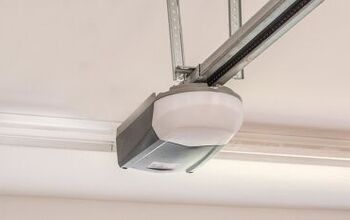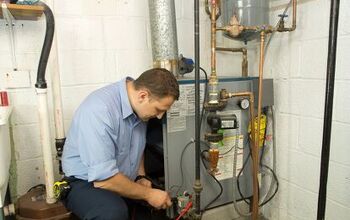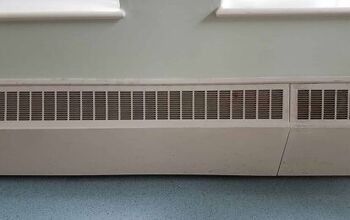Garage Door Lights Won't Turn Off? (Possible Causes & Fixes)

You can Garage doors regularly malfunction. Components of the door can sometimes become jammed or fail to operate as they should. If your garage door light isn’t turning off, use this as a guide, as it can quickly wear down the light’s battery.
When your garage door light doesn’t turn off, there could be several issues. However, the most common causes are the door’s motion sensor or the light timer. You will need to turn off the door’s motion sensor lights by disengaging the setting on the wall-mounted panel.
Do You Need to Hire an Electrician?
Get free, zero-commitment quotes from pro contractors near you.

Why Won’t The Garage Door Light Turn Off?
If your garage door light won’t turn off, there is likely a problem with the garage door’s motion sensor or light timer. Something may be triggering the garage door motion sensors, which turn the lights on and off automatically. You may have left the panel light switch on, or engaged the garage door’s light feature.
How To Troubleshoot The Garage Door Light
Garage door openers are very convenient until they stop working. If your garage door light stays on, you may have a problem. You should first look through your owner’s manual for the model number and other important information.
In most cases, you may be able to fix the garage door yourself. However, you should hire a professional if the issue is more serious and involves electrical panels.
Here are common reasons why the garage door light won’t turn off.
The Ground Wires Are Loose
Over time ground wires can become loose, which can cause the wall receptacle or garage door opener motor to be defective. To find out if this is the problem, check the yellow wire between the motor housing and the wall control unit.
It should not be loose, and there shouldn’t be any wires touching near the screw terminal. If all the connections look okay, you may need to replace the yellow wire.
You Need To Replace The Wall Switch
Remove the wall switch and disconnect the wires to see if the light stays on. If they do, the logic board is likely broken. If the lights remain off when the wires are disconnected, you should replace the wall switch unit.
Broken Logic Board
The logic board controls the garage door opener. If the lights stay on when disconnected from the wall, the logic board may have a stuck relay. Fixing a logic board is tricky and typically requires help from a professional technician to repair it.
The Light Switch Is Enabled
Sometimes the garage door light stays on because the light switch is enabled on the mounted wall panel. Check that you haven’t hit the light switch on your wall panel. If this is the case, the garage door opener light will remain on until you press the button to turn it off.
Something Triggered The Motion Sensors
A benefit of a garage door system is there are motion sensors that trigger the lights to come on when it senses movement. If you want to disengage this feature, access your wall-mounted panel, select Menu, Light Settings, then Automatic Light.
You will have two options, choose the one that says Motion Sensor and press the off button. The motion sensor light will not come on when it detects movement. If you change your mind in the future, you can reverse this setting.
Something Activated The Light Feature
The light feature was designed as a safety feature so that you don’t have to enter into a dark garage. The garage door light may be staying on because the light feature has been activated. This happens when the signal between the photo eye sensors is interrupted when entering or exiting the garage.
If you want to turn off this feature, go to Menu, Light Settings, Automatic Light, then Entry Sensor. You will then have the option to turn the sensor off. If you change your mind, you can follow the same steps and turn it back on.
Types Of Garage Doors
Garage doors are available in a variety of materials, finishes, colors, and features. There are also several different types of garage doors, as there is no one-size-fits-all option. The most common garage doors are section, roll-up, slide to the side, side hinged, tilt-up canopy, and tilt-up retractable.
Sectional Garage Door
A sectional garage door, typically made from steel, is the most popular type in the United States. This low-maintenance door features panel sections connected with hinges.
As the door opens and closes, the wheels at the edge of each panel roll inside a vertical track. The tracks are on each side of the door opening.
The hinges between each panel bend over a curved part of the track. This allows the door to sit parallel to the ceiling when completely open. When the garage is entirely closed, the panels are in line with the walls.
High-tension springs attached to cables are above the opening of the garage. The pair operate the door and hold it down from moving when it isn’t open completely.
Roll Up Garage Door
The roll-up garage door features a simple design and is popular in commercial properties. This door is built for limited ceiling space and features 2 to 3-inch steel slat sections. These are heavy-duty and built to withstand repeated usage.
Roll-up garage doors can be built without springs or enclosed in order to prevent rust, corrosion, or freezing. Because these are primarily commercial doors, the costs are higher than sectional garage doors.
Slide To The Side Garage Door
A slide to the side garage door functions just as its name states. The door bends to one side of the garage and sits parallel to the wall. This is one of the original styles of garage doors and people originally used them where headroom wasn’t available.
These garage doors are flexible, so they work well with slopes in the floor or ceiling. A slide to the side garage door doesn’t require balancing springs and has a built-in retractable motor. You can operate the garage door without a ceiling-mounted operator.
Side-Hinged Garage Door
A side-hinged garage door opens and closes from a hinge on either side of the opening. These garage doors resemble a barn door and consist of wood; commercial types are available in galvanized steel, too.
In recent years, these garage doors have become more popular in garages that have limited headroom. You can purchase side-hinged garage doors in pre-hung frames or fit into existing openings. You can also choose a side-hinged garage door featuring automation with conversion arms.
Tilt-Up Canopy Garage Door
Like side-hinged garage doors, the tilt-up canopy garage door doesn’t have sections; it consists of one piece. There is a pivoting mechanism that allows it to tilt up into the garage. The canopy door sits parallel to the garage ceiling and extends past the front of the house when the door is open.
Tilt-Up Retractable Garage Door
The tilt-up retractable garage door is similar to the tilt-up canopy design and lifts up and into the garage. The garage door doesn’t protrude past the front of the house because it suspends from the frame.
This garage door requires more space than canopy garage doors. They are also more difficult to operate than other styles and more expensive.
Do You Need to Hire an Electrician?
Get free, zero-commitment quotes from pro contractors near you.

Related Questions
What’s does a new garage door cost, on average?
On average, installing a garage door costs $1,138 but can range from $756 to $1,567. A standard single garage door ranges from $600 to $1,500 for installation; a double garage door ranges from $800 to $1,500 for installation. Keep in mind that labor costs are typically $300 per unit, but a new garage door is $300 to $1,100. Professionals will price your project to include labor, the garage door, track, and any additional hardware needed. Keep in mind that if you have a homeowners association, there may be strict requirements for materials and designs. If you are changing electrical or structural parts of the garage, you will need a permit to do so.
How often should I have a pro service a garage door?
If there are no other issues, you should service your garage door at least once a year. Having a technician service your garage door can prolong its life and prevent future maintenance. A service technician will lubricate areas of the door, tighten any bolts or screws, and adjust spring tension. It’s a good idea to do your own monthly check of the garage door. Some things to consider are if you can open the door manually from the outside without the opener. Check for any broken glass, and listen for any unusual noises. If you hear a whine or click when the door opens, you may need to call for service. Although your garage door may work fine, an annual or monthly service will prevent issues from arising in the future.
What’s the difference in cost between a manual garage door and an automatic garage door?
On average, a manual garage door ranges in price from $600 to $2,150. Making a manual garage door automatic can add $200 to $1,300 to the cost. Furthermore, an automatic garage door increases the price due to a variety of factors.An automatic garage door opener ranges from $225 to $525 to install, and extra remotes can cost $20 to $60. If you need to install a new garage door opener, it will require a new circuit. A new circuit runs $500 to $800, and an electrical outlet can range from $100 to $185.

Stacy Randall is a wife, mother, and freelance writer from NOLA that has always had a love for DIY projects, home organization, and making spaces beautiful. Together with her husband, she has been spending the last several years lovingly renovating her grandparent's former home, making it their own and learning a lot about life along the way.
More by Stacy Randall



























